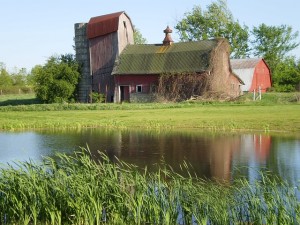Fertilizer and Water Quality Metric
 Improper usage of fertilizer can pose serious threats to water quality due to its propensity of permeating into ground and surface water through runoff or simple leaching. Two critical components in commercial fertilizers that present direct risk to water contamination are nitrogen and phosphorus (EPA 2010). According to the EPA’s ‘Source Water Protection Practices Bulletin,’ it is estimated that about 25 percent of all pre-plant nitrogen applied to corn is lost through leaching (entering ground water as nitrate) or denitrification (entering the atmosphere as nitrogen gas). The mobility of phosphorus can also cause severe water quality impairment since as much as 60 to 90 percent of phosphorus moves with the soil. Hence, careful usages of a fertilizer that takes its negative ramifications into consideration and develops an effective application management strategy are vital procedures to reduce the level of water impairments.
Improper usage of fertilizer can pose serious threats to water quality due to its propensity of permeating into ground and surface water through runoff or simple leaching. Two critical components in commercial fertilizers that present direct risk to water contamination are nitrogen and phosphorus (EPA 2010). According to the EPA’s ‘Source Water Protection Practices Bulletin,’ it is estimated that about 25 percent of all pre-plant nitrogen applied to corn is lost through leaching (entering ground water as nitrate) or denitrification (entering the atmosphere as nitrogen gas). The mobility of phosphorus can also cause severe water quality impairment since as much as 60 to 90 percent of phosphorus moves with the soil. Hence, careful usages of a fertilizer that takes its negative ramifications into consideration and develops an effective application management strategy are vital procedures to reduce the level of water impairments.
The fertilizer metric uses the U.S. Department of Agriculture’s National Agricultural Statistics Service’s cropland database and data from the U.S. Department of Agriculture’s Economic Research Service for the land use and the fertilizer-applied amount (nitrogen, phosphorus, and potassium). By using these data along with GIS software, the potential runoff for each component is estimated in the ten considered states.
Preview of Results
Metric Findings
-
Assumptions:
- The acreage of corn, soybeans, and wheat within each state are calculated using the U.S. Department of Agriculture’s National Agricultural Statistics Service’s cropland database
- The U.S. Department of Agriculture’s Economic Research Service was used to determine how much fertilizer was applied to each of the types of crop
-
Findings:
- After ranking all of watersheds in the 10 considered, the average ranking of each state’s watershed was determined
- Indiana ranks 8th out of the 10 states in the potential for both nitrogen and phosphorus runoff. It ranks 9th in the potential for potassium runoff
-
Policy Considerations:
- The results of this metric do not indicate that a state will have more, or less, issues with water quality due to fertilizer pollution, but rather it quantifies the potential for nutrient pollution of water bodies within each state
- A state that applies more fertilizer than another state would have more issue related to fertilizer pollution
